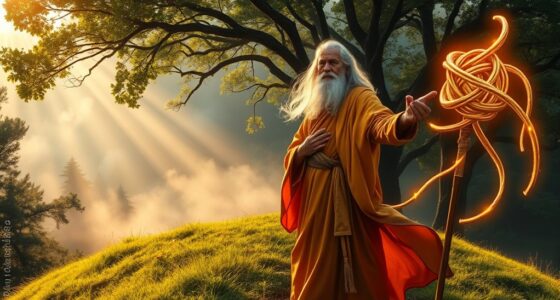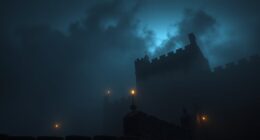Many believe that full moons boost paranormal activity, but scientific research shows no solid evidence to support this idea. While cultural stories and media often link lunar phases to supernatural events, studies find little to no impact on human behavior or unexplained occurrences. Most reports during a full moon can be attributed to psychological biases or environmental factors. To uncover how these myths originated and what science really says, keep exploring further.
Key Takeaways
- Scientific studies find no conclusive evidence linking full moons to increased paranormal activity.
- Media and pop culture often dramatize full moon effects, reinforcing myths and perceptions.
- Cultural beliefs associate full moons with transformation and supernatural events, influencing behaviors and stories.
- Psychological biases, like confirmation bias, cause people to notice and interpret normal events as paranormal during full moons.
- Tidal and gravitational effects of the moon have minimal impact on human behavior or supernatural phenomena.
The Origins of Full Moon Superstitions

Many full moon superstitions trace back to ancient times when people observed its bright, unpredictable glow and believed it influenced behavior and events. They saw the full moon as more than just a celestial body; it held deep symbolic meaning within moon phase symbolism. Cultures linked the full moon to transformation, fertility, and chaos, often interpreting its presence as a sign of change. The lunar calendar significance played a key role, as societies tracked the moon’s cycles to schedule planting, harvesting, and rituals. This connection fostered beliefs that specific moon phases, especially the full moon, held power over human actions and natural phenomena. Additionally, these beliefs were reinforced by the diverse cultural interpretations of lunar influence that varied across regions and eras. Over centuries, these ideas embedded into folklore and superstition, shaping how generations perceived the moon’s influence on life and behavior. Modern scientific research continues to explore whether the full moon genuinely impacts human activity or if these beliefs are primarily cultural constructs. Studies also show that the historical significance of lunar cycles contributed to the persistence of these myths over time, and ongoing research examines how psychological factors might influence perceptions of lunar effects. Furthermore, cognitive biases can lead individuals to notice and remember events that confirm their lunar-related beliefs more than those that do not.
Scientific Investigations Into Lunar Effects on Behavior

Scientists have long sought to determine whether the full moon truly influences human behavior or if such beliefs are simply rooted in tradition and folklore. Researchers examine correlations between moon phases and activities like sleep patterns, aggression, and mood changes. Some studies explore gravitational effects, questioning if the moon’s pull affects our bodies similarly to ocean tides. Additionally, synthetic wigs are often used during Halloween costume preparations, but they require careful styling to avoid damage. However, scientific evidence remains mixed and often inconclusive. The lunar cycle has been a part of human culture for centuries, fueling myths and superstitions about full moons. Key findings include: – Many studies find no significant link between lunar cycles and behavior. – Observations suggest that perceived effects may result from confirmation bias or cultural expectations. – Large-scale research continues to analyze data to identify subtle influences, if any, of gravitational effects during full moons. The variability in results may also be due to the limitations of observational studies, which often cannot control for all confounding variables. Moreover, some researchers investigate behavioral patterns in populations during different moon phases to better understand potential links. Additionally, recent advances in statistical analysis help improve the accuracy of such studies by accounting for external factors.
The Psychology Behind Full Moon Myths

The full moon has long been associated with strange behaviors and heightened emotions, but much of this belief stems from psychological factors rather than scientific evidence. Moon imagery plays a powerful role in shaping your perceptions, reinforcing the idea that the full moon causes unusual events. Psychological biases like confirmation bias lead you to notice and remember incidents that support this belief, while ignoring contradicting evidence. The vivid imagery of a glowing moon can evoke feelings of mystery and fear, making you more likely to interpret ambiguous behaviors as lunar-driven. This mental framing creates a self-fulfilling cycle—your expectations influence your interpretation of events, reinforcing myths about the full moon’s impact. Additionally, cognitive biases can distort how you perceive lunar effects, further fueling these myths. For instance, perceptual distortions can cause you to see patterns that aren’t actually present, which sustains the belief in lunar influence. The psychological factors involved also include selective attention, which causes you to focus on moon-related incidents more than others, even if they are equally unremarkable. These psychological factors, including selective attention, explain why full moon stories persist, even without scientific backing.
Analyzing Paranormal Reports During a Full Moon

Why do reports of paranormal activity tend to spike during a full moon? Many believe the moon phases amplify lunar influence, making people more sensitive to supernatural events. During a full moon, the increased brightness and cultural associations heighten awareness and fear. This often leads to a rise in paranormal reports, even if the actual activity isn’t any more frequent. Additionally, the bank and finance sector’s varied hours during holidays can influence the timing of reports or investigations, as people may seek financial services or report incidents when branches are open or closed.
Consider these factors:
- Psychological Expectation: People anticipate more activity, so they interpret normal occurrences as paranormal.
- Environmental Changes: The full moon’s light may influence animal behavior, prompting unusual noises that are mistaken for ghosts.
- Cultural Reinforcement: Stories and myths about full moons encourage individuals to notice and report strange phenomena during this time.
The Role of Media and Popular Culture in Shaping Perceptions

Media and popular culture play a powerful role in shaping how you perceive full moons and their connection to paranormal activity. Through movies, TV shows, and books, you’re exposed to stories that often link a full moon with increased supernatural events or bizarre behavior. Media influence amplifies these associations, making it seem like full moons are a trigger for the extraordinary. Pop culture reinforces these ideas by dramatizing full moon myths, which can influence your beliefs and expectations. As a result, you may become more attentive to strange occurrences during a full moon, subtly reinforcing the myth. This cycle creates a feedback loop where media and pop culture shape your perception, even if scientific evidence doesn’t support a direct connection.
Comparing Different Cultures’ Views on Full Moon Phenomena

Different cultures interpret the full moon in unique ways, shaping their legends and beliefs. You’ll find that lunar stories vary widely, from symbols of transformation to omens of change. Exploring these cultural differences reveals how deeply the moon influences human traditions worldwide.
Lunar Legends Worldwide
Across cultures worldwide, the full moon has sparked a rich tapestry of legends and beliefs that reflect diverse perceptions of its power and significance. In many societies, lunar symbolism embodies cycles of renewal, fertility, and mystery. For example, in Chinese mythology, the moon is linked to the goddess Chang’e, symbolizing immortality and longing. Native American tribes often see the full moon as a time for healing and spiritual insight. Meanwhile, in Hindu tradition, the mythological significance of the full moon is tied to lunar deities and the idea of cosmic balance. These lunar legends reveal how different cultures interpret the moon’s influence, shaping rituals and stories that emphasize its mythological significance and enduring mystique.
- Chinese legend of Chang’e and the moon goddess
- Native American moon dances for spiritual power
- Hindu lunar deities representing cosmic harmony
Cultural Beliefs Variations
The full moon’s significance varies widely among cultures, shaping unique beliefs and practices that reflect their worldview. In some societies, moon symbolism is linked to fertility, renewal, or spiritual guidance, influencing rituals performed during full moons. For example, certain indigenous groups conduct celestial rituals to honor the moon’s power, believing it governs life cycles and natural forces. Other cultures see the full moon as a time of chaos or danger, leading to protective customs or taboos. These diverse beliefs highlight how the full moon’s meaning adapts to cultural contexts, shaping behaviors and mythologies. Understanding these variations reveals that perceptions of the full moon are deeply rooted in cultural identity, affecting everything from spiritual practices to societal norms across the globe.
What Does the Research Say About the Actual Influence of the Moon?

While many people believe the full moon influences behavior and health, scientific research offers little supporting evidence. Studies have explored links between moon phases and phenomena like sleep disturbances or increased emergency room visits, but results are inconclusive. Most research shows no significant connection between lunar cycles and human activity beyond coincidence. The idea that full moons cause paranormal activity or heightened emotions remains unsubstantiated. notably, tidal effects caused by the moon’s gravitational pull are well-understood, but their influence doesn’t extend to human behavior. Researchers emphasize that psychological biases, such as the confirmation bias, often lead people to notice events they associate with the full moon while ignoring the times when nothing happens. Overall, current evidence doesn’t support a meaningful lunar impact on us.
Frequently Asked Questions
Are There Any Scientific Studies Proving a Full Moon Increases Paranormal Activity?
You might wonder if science proves a full moon boosts paranormal activity. While there’s no solid evidence, studies show full moons can influence wildlife behavior and cause tidal variations. These natural effects might make you feel more anxious or observant, but they don’t directly increase paranormal events. So, the idea that a full moon causes more paranormal activity remains unproven, mainly based on myths rather than scientific fact.
How Do Cultural Differences Influence Beliefs About Full Moon Effects?
You might notice that cultural differences shape how people interpret full moon effects. In some cultures, folklore traditions and cultural rituals honor the full moon, believing it influences behaviors and events. These beliefs influence your perceptions and stories you hear, making the full moon seem more powerful or mystical. Your cultural background affects whether you see the full moon as a time for special rituals or supernatural activity, reinforcing diverse beliefs worldwide.
Can Lunar Cycles Affect Human Biological Processes Beyond Behavior?
You might wonder if lunar influence extends beyond behavior to impact your biological rhythms. Scientific evidence suggests that lunar cycles could subtly affect sleep patterns, hormone production, and other biological processes. While these effects are less dramatic than mythic tales, your body’s natural rhythms might still be influenced by the moon’s cycles, aligning with some studies that highlight the connection between lunar influence and human biological processes.
What Historical Events Are Linked to Full Moon Superstitions?
Think of history as a tapestry woven with moonlit threads, where full moon superstitions shine brightly. You’ll find links to lunar eclipses fueling fears, and werewolf legends emerging from the shadows of full moons. Ancient cultures, like the Greeks and Romans, associated these luminous nights with supernatural events, often fearing madness or monsters. These stories still echo today, keeping the moon’s mysterious influence alive in our collective imagination.
Is There a Correlation Between Full Moon Phases and Crime Rates?
You might wonder if the moonlight influence affects crime rates. While some studies suggest a correlation, many experts believe lunar psychology impacts behavior more subtly. The full moon’s bright light can increase alertness and agitation, potentially leading to more incidents. However, evidence remains mixed, and most researchers agree that environmental and social factors play a bigger role. So, it’s not definitive—your behavior during a full moon may be influenced more by perception than reality.
Conclusion
Just like the moon’s glow illuminates the night sky, your beliefs about full moons can shine brightly or fade away. While science suggests there’s little proof of increased paranormal activity, myths persist, fueled by culture and perception. Remember, it’s your mind that often shapes what you see in the darkness. So, next time the full moon rises, consider whether it’s your imagination or something truly mysterious—either way, it’s sure to captivate your curiosity.









